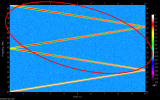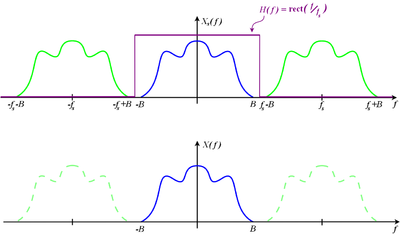I still don't understand. The real signal is DC-22kHz in 10second. What is the line above that.
Ahh, sorry, that one, it is just one way sweep from DC to 22.05 kHz.
Those lines above 22.05 kHz are images. On PCM, the frequency spectrum keeps repeating itself. Next band above Nyquist is inverse frequency spectrum. And then again above sampling rate it is forward and then from 44.1k + 22.05k = 66.15k it is inverse again. And so on.
Or in other words,
x * fs below sampling rate you have "negative frequencies" and inverse frequency spectrum. And above sampling rate you have "positive frequecies" and forward frequency spectrum. Here "x" can be any number from 0 to infinity.
In order to correctly reconstruct analog signal from PCM, everything above Nyquist frequency must be removed. So if we start with RedBook (CD), with 44.1 kHz sampling rate and 16-bit this means you need a very steep filter to attenuate frequencies above 22.05 kHz by at least 96 dB to correctly reconstruct 16-bit resolution. For 24-bit resolution you need at least 144 dB attenuation and for 32-bit you would need 192 dB attenuation.
Using digital filters we can achieve enough steepness to do this, as you can see from my above example. If we use digital filters to increase sampling rate to 352.8 kHz like DAC chips do, these images move be around multiples of 352.8 kHz. DAC chips don't have enough DSP processing power to do proper digital filters above this, so you can see images around multiples of 352.8 kHz. If you do this externally, many DAC chips allow you to use 705.6 kHz sampling rate instead, which means these images move to around multiples of 705.6 kHz. If we could use high enough sampling rate, eventually the analog output filter in DAC would be able to attenuate these images enough. Typical analog filter in a DAC is 2nd order Butterworth with -3 dB point at 100 kHz. This means it as 12 dB/oct attenuation. Thus, for 96 dB attenuation, we would need 8 octaves. And for 144 dB attenuation we would need 12 octaves. And for 192 dB attenuation we would need 16 octaves.
With DSD output and enough DSP power, we can do digital filters for example to 44.1 x256 rate = 11.2896 MHz or 44.1 x512 = 22.5792 MHz. With number of DACs on the market we can also use 44.1 x1024 rate = 45.1584 MHz digital filter output rates. Thus these images are not an issue anymore. OTOH, if we already record at for example DSD256, we don't need to employ these kind of oversampling filters at all.
This is just the output side.
At input side, the problem is even more severe. If we don't employ steep digital filter, all the information outside of
fs/2 will fold down to the
0 - fs/2 band. Here's an example of 0 - 176.4 kHz sweep at 352.8 kHz sampling rate, converted to 44.1 kHz 16-bit, without digital filter:
Whenever you do band limiting with filters, it has both frequency and time domain implications, because the two are linked through 1/x relationship.


